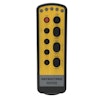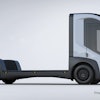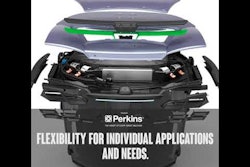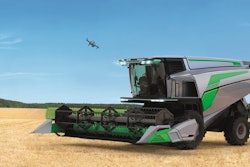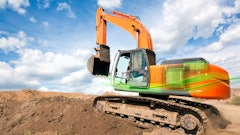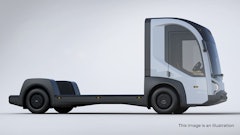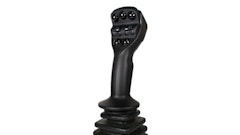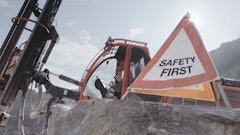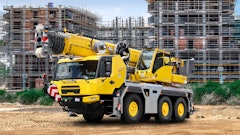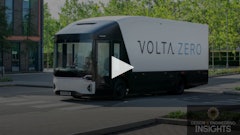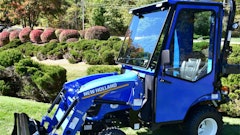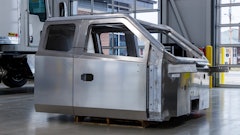 Caterpillar Inc.
Caterpillar Inc.
Oftentimes, the cab’s actual structure can seem forgotten amidst the fancier bells and whistles of the operator interface technology advancements, but there are several important considerations undertaken by cab manufacturers that should not go unnoticed.
"Like with any machine or component or system in a machine, it starts with the requirements," says Paul Taylor, Senior Manager for Material Handling and Underground at Caterpillar Inc., and formerly the worldwide new product introduction manager for the articulated trucks segment. "Requirements come from three places: Voice of the Customer, Voice of the Business, and Voice of Regulations." The three unique perspectives from customer, business and regulation allow a designer to make critical product decisions to fulfill expectations.
 The Caterpillar 740 GC articulated dump truck.Caterpillar Inc.
The Caterpillar 740 GC articulated dump truck.Caterpillar Inc.
Approximately 40 hours of in-cab footage was reviewed to verify how cab operators actually worked inside a cab to correlate movements and actions with the operator-requested functionalities. The Voice of Business, Taylor points out, involved gathering a large amount of information from the competition to evaluate differentiating features and possible areas of improvement. And lastly, the Voice of Regulation deals largely with visibility. "You have to, for example, have the A and B pillars of the cab structure restrict a certain amount of visibility. If they get too big, visibility regulations won't be met," explains Taylor.
Visibility
There are few safety measures more important for operator and ground-worker safety than cab visibility. A blind-spot is a dangerous thing, and technology providers and OEMs work hand-in-hand to eliminate any opportunity for injury. While a top-mounted 360-degree camera or object-detection systems are great back-up systems for worker protection, ultimately the first line of defense is the operator’s own eyes to avoid dangerous situations from the onset. Read about the latest in object and proximity detection systems online at oemoh.com/proximity.
 The two-person cab for Caterpillar's 740 GC articulated dump truck features its "external spinal-ROPS" system.Caterpillar Inc.
The two-person cab for Caterpillar's 740 GC articulated dump truck features its "external spinal-ROPS" system.Caterpillar Inc.
When it comes to visibility, a cab manufacture must strike a fine balance between the structural integrity of the cab, its ROPS/FOPS system (roll-over protective structure/falling object protective structure), overall weight and an actual reduction in materials to leave plenty of room for viewing spaces.
Modularity
Because the operator cab’s interface and advanced technologies are constantly evolving, that impacts and informs the design evolution of the cab structure itself. This makes for an extremely diverse and constantly changing cab industry. To answer this industry challenge, three cab manufacturers—Lochmann Kabinen GmbH, Siac S.p.A. and KML GmbH—presented together at one bauma 2019 booth to explain their product portfolio and future strategic goals.
 KML cabinKML GmbH
KML cabinKML GmbH
Lochmann Kabinen specializes in medium-sized series manufacturing between 50 and 500 cab units; Siac is geared toward industrial production and concentrates on large series manufacturing over 500 units; and KML Kabinen manufactures high-tech cabins in single units, smaller series and large cabins up to about 100 units.
"Despite the diversification of the individual companies, we want to share our development competences and production resources together in order to be able to offer our customers optimal cabin solutions and individually suitable production resources," says Stefan Lochmann, Managing Director at Lochmann Kabinen GmbH.
 An exploded version of the CAB Concept Cluster's Smart CAB for agricultural applications.CCC
An exploded version of the CAB Concept Cluster's Smart CAB for agricultural applications.CCC
One of the cab’s founding members was FRITZMEIER Cabs which supplied an integrated SoftCab hybrid structure solution made of welded special aluminum profiles. The structure design led to a weight reduction of 30%. EXO-ROPS steel elements can be added to the cab and configured for weight classes between 10 and 50 tonnes.
The cab was built in a modular fashion to reduce time requirements and costs resulting from development. The second generation of the Genius CAB—the Smart CAB—launched at Agritechnica 2017. The cab’s steel structure, including substructure groups, such as glazing and cladding parts, is based on a serial-tested product by FRITZMEIER.
Broadening cab capabilities
As the pace of operator interface technologies has quickened, several cab manufacturers have realized that being able to design, prototype, test, and manufacture a fully integrated cab system is essential for faster time-to-delivery for OEM customers.
GS Global Resources (GSGR) announced its acquisition of ADC Custom Products (now renamed ADC Equipment Innovations)—a leader in ROPS and FOPS systems for heavy-duty equipment—back in February of 2018.
GSGR offers a broad product portfolio and engineering expertise ranging from hydraulic to electronic, mechanical and software capabilities. With this acquisition, GS Global Resources is able to offer a single point-of-contact for OEM customers in search of fully-integrated cabs.
“We’ve always delivered pragmatic system and component design, innovative and reliable technologies, as well as production and market support through a single point of engineering accountability,” GS Global Resources President John Thornton says. “Now ADC Equipment Innovations makes interacting with us even easier for customers.
“Acquiring this highly-specialized technical knowledge of designing and building structures to protect machine operators reduces cost, decreases engineering effort and time, and streamlines manufacturing processes for OEMs,” Thornton adds.
Just a couple of months later, MSK Group of Finland expanded its reach in Europe with the acquisition of Matec GmbH, a cab manufacturer operating in Germany and Slovakia with well-known OEM clients such as Volvo Construction Equipment, Liebherr and Komatsu.
 Constructed Genius CABs at FRITZMEIER.FRITZMEIER Cabs
Constructed Genius CABs at FRITZMEIER.FRITZMEIER Cabs
A relatively recent consideration factoring into cab design is “future-proofing” as integrated technologies continue to change and update. “If you look forward, there will be a lot of improvements focused on productivity in terms of how to make iron smarter, whether that means diagnostics or prognostics, performance reporting, or semi- to fully autonomous systems and features,” explains Taylor.



